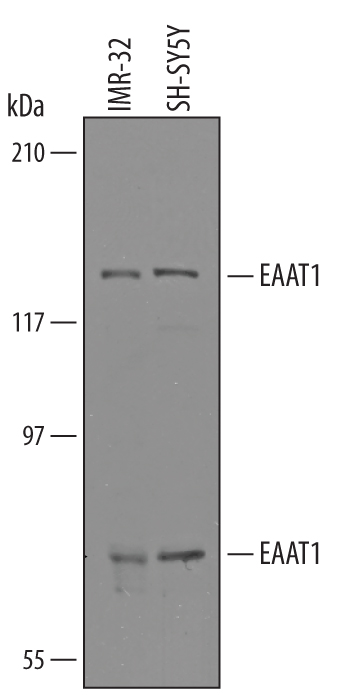Human EAAT1/GLAST-1 Antibody Summary
His146-Ser237
Accession # P43003
Applications
Please Note: Optimal dilutions should be determined by each laboratory for each application. General Protocols are available in the Technical Information section on our website.
Scientific Data
 View Larger
View Larger
Detection of Human EAAT1/GLAST‑1 by Western Blot. Western blot shows lysates of IMR-32 human neuroblastoma cell line and SH-SY5Y human neuroblastoma cell line. PVDF Membrane was probed with 1 µg/mL of Sheep Anti-Human EAAT1/GLAST-1 Antigen Affinity-purified Polyclonal Antibody (Catalog # AF6048) followed by HRP-conjugated Anti-Sheep IgG Secondary Antibody (Catalog # HAF016). Specific bands were detected for EAAT1/GLAST-1 at approximately 60 and 120 kDa (as indicated). This experiment was conducted under reducing conditions and using Immunoblot Buffer Group 1.
 View Larger
View Larger
EAAT1/GLAST‑1 in Human Brain. EAAT1/GLAST-1 was detected in immersion fixed paraffin-embedded sections of human brain (caudate nucleus) using Sheep Anti-Human EAAT1/GLAST-1 Antigen Affinity-purified Polyclonal Antibody (Catalog # AF6048) at 3 µg/mL overnight at 4 °C. Before incubation with the primary antibody, tissue was subjected to heat-induced epitope retrieval using Antigen Retrieval Reagent-Basic (Catalog # CTS013). Tissue was stained using the Anti-Sheep HRP-DAB Cell & Tissue Staining Kit (brown; Catalog # CTS019) and counterstained with hematoxylin (blue). Specific staining was localized to neuronal processes and presynaptic profiles. View our protocol for Chromogenic IHC Staining of Paraffin-embedded Tissue Sections.
Reconstitution Calculator
Preparation and Storage
- 12 months from date of receipt, -20 to -70 °C as supplied.
- 1 month, 2 to 8 °C under sterile conditions after reconstitution.
- 6 months, -20 to -70 °C under sterile conditions after reconstitution.
Background: EAAT1/GLAST-1
GLAST-1 (Sodium dependent GLu/ASp Transporter 1; also SLC1A3 and EAAT1) is a 60‑62 kDa member of the SDF symporter family of molecules. It is expressed by glia, fibroblasts, and select neuron cell types such as hippocampal neurons. EAAT1 is known to transport L‑glutamate into glia, thus removing glutamate from synaptic areas where it either acts too long, or becomes toxic at elevated concentration. Its action is dependent on its ability to cotransport sodium. Human EAAT1 is a 542 amino acid (aa), 8-transmembrane variably glycosylated protein that contains N- and C-terminal cytoplasmic domains. Homodimers are reported to exist, but only when EAAT1 shows glycosylation. There are at least two potential isoform variants. One shows an Arg substitution for aa 430‑475, while a second shows a four aa substitution for aa 62‑542. Over an extracellular loop that encompasses aa 146‑237, human EAAT1 shares 92% aa identity with mouse EAAT1.
Product Datasheets
FAQs
No product specific FAQs exist for this product, however you may
View all Antibody FAQsReviews for Human EAAT1/GLAST-1 Antibody
There are currently no reviews for this product. Be the first to review Human EAAT1/GLAST-1 Antibody and earn rewards!
Have you used Human EAAT1/GLAST-1 Antibody?
Submit a review and receive an Amazon gift card.
$25/€18/£15/$25CAN/¥75 Yuan/¥2500 Yen for a review with an image
$10/€7/£6/$10 CAD/¥70 Yuan/¥1110 Yen for a review without an image



